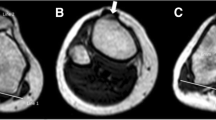Abstract
Purpose
Increased tibial tuberosity-trochlear groove distance (TTTG) is one potential correcting parameter in patients suffering from lateral patellar instability. It was hypothesized that end-stage extension of the knee might influence the TTTG distance on MR images.
Methods
Transverse T1-weighted MR images of the knee were acquired at full extension, 15° and 30° flexion of the knee in 30 asymptomatic volunteers. MRI parameters: slice thickness: 3 mm, matrix: 256 × 384, FOV: 150 × 150 mm. Two observers independently measured the TTTG at all positions.
Results
Mean TTTG for observer 1 was 15.1 ± 3.2 mm at full extension, 10.0 ± 3.5 mm at 15° flexion and 8.1 ± 3.4 mm at 30° flexion. Mean TTTG for observer 2: 14.8 ± 3.3 mm at full extension, 9.4 ± 3.0 mm at 15° flexion, 8.6 ± 3.4 mm at 30° flexion. Mean values were significantly different (p < 0.001) between full extension and 15° as well as 30° flexion for both observers. Mean values were significantly different (p < 0.001) between 15° and 30° for observer 1, but not for observer 2 (n.s.). Interobserver agreement was very good (intraclass correlation coefficient: 0.87–0.88; p < 0.001).
Conclusions
The TTTG increases significantly at the end-stage extension of the knee. Therefore, the comparability of published TTTG values measured on radiographs, CT and MRI at various flexion/extension angles of the knee are limited.
Level of evidence
Development of diagnostic criteria in a consecutive series of patients and a universally applied ‘gold’ standard, Level II.

Similar content being viewed by others
References
Alemparte J, Ekdahl M, Burnier L et al (2007) Patellofemoral evaluation with radiographs and computed tomography scans in 60 knees of asymptomatic subjects. Arthroscopy 23:170–177
Balcarek P, Jung K, Ammon J et al (2010) Anatomy of lateral patellar instability: trochlear dysplasia and tibial tubercle-trochlear groove distance is more pronounced in women who dislocate the patella. Am J Sports Med 38:2320–2327
Balcarek P, Jung K, Frosch KH et al (2011) Value of the tibial tuberosity-trochlear groove distance in patellar instability in the young athlete. Am J Sports Med 39:1756–1761
Bull AM, Kessler O, Alam M et al (2008) Changes in knee kinematics reflect the articular geometry after arthroplasty. Clin Orthop Relat Res 466:2491–2499
Cooney AD, Kazi Z, Caplan N et al (2012) The relationship between quadriceps angle and tibial tuberosity-trochlear groove distance in patients with patellar instability. Knee Surg Sports Traumatol Arthrosc 20:2399–2404
Dejour H, Walch G, Nove-Josserand L et al (1994) Factors of patellar instability: an anatomic radiographic study. Knee Surg Sports Traumatol Arthrosc 2:19–26
Diederichs G, Issever AS, Scheffler S (2010) MR imaging of patellar instability: injury patterns and assessment of risk factors. Radiographics 30:961–981
Goutallier D, Bernageau J, Lecudonnec B (1978) The measurement of the tibial tuberosity. Patella groove distanced technique and results. Rev Chir Orthop Reparatrice Appar Mot; 64:423–428
Hamai S, Morooka TA, Miura H et al (2009) Knee kinematics in medial osteoarthritis during in vivo weight-bearing activities. J Orthop Res 27:1555–1561
Jones RB, Barlett EC, Vainright JR et al (1995) CT determination of tibial tubercle lateralization in patients presenting with anterior knee pain. Skeletal Radiol 24:505–509
Koëter S, Diks MJ, Anderson PG et al (2007) A modified tibial tubercle osteotomy for patellar maltracking: results at two years. J Bone Joint Surg Br 89:180–185
Merican AM, Ghosh KM, Iranpour F et al (2011) The effect of femoral component rotation on the kinematics of the tibiofemoral and patellofemoral joints after total knee arthroplasty. Knee Surg Sports Traumatol Arthrosc 19:1479–1487
Miyanishi K, Nagamine R, Murayama S et al (2000) Tibial tubercle malposition in patellar joint instability: a computed tomograpy study in full extension and at 30 degree flexion. Acta Orthop Scand 71:286–291
Nagamine R, Miura H, Inoue Y et al (1997) Malposition of the tibial tubercle during flexion in knees with patellofemoral arthritis. Skeletal Radiol 26:597–601
Nagao N, Tachibana T, Mizuno K (1998) The rotational angle in osteoarthritic knees. Int Orthop 22:282–287
Pandit S, Frampton C, Stoddart J et al (2011) Magnetic resonance imaging assessment of tibial tuberosity–trochlear groove distance: normal values for males and females. Int Orthop 35:1799–1803
Piazza SJ, Cavanagh PR (2000) Measurement of the screw-home motion of the knee is sensitive to errors in axis alignment. J Biomech 33:1029–1034
Schoettle PB, Zanetti M, Seifert B et al (2006) The tibial tuberosity-trochlear groove distance; a comparative study between CT and MRI scanning. Knee 13:26–31
Shakespeare D, Fick D (2005) Patellar instability-can the TT-TG distance be measured clinically? Knee 12:201–204
Smith TO, Davies L, Toms AP et al (2010) The reliability and validity of radiological assessment for patellar instability. A systematic review and meta-analysis. Skeletal Radiol 40:399–414
Tecklenburg K, Feller JA, Whitehead TS et al (2010) Outcome of surgery for recurrent patellar dislocation based on the distance of the tibial tuberosity to the trochlear groove. J Bone Joint Surg Br 92:1376–1380
Wittstein JR, Bartlett EC, Easterbrook J et al (2006) Magnetic resonance imaging evaluation of patellofemoral malalignment. Arthroscopy 22:643–649
Author information
Authors and Affiliations
Corresponding author
Rights and permissions
About this article
Cite this article
Dietrich, T.J., Betz, M., Pfirrmann, C.W.A. et al. End-stage extension of the knee and its influence on tibial tuberosity-trochlear groove distance (TTTG) in asymptomatic volunteers. Knee Surg Sports Traumatol Arthrosc 22, 214–218 (2014). https://doi.org/10.1007/s00167-012-2357-z
Received:
Accepted:
Published:
Issue Date:
DOI: https://doi.org/10.1007/s00167-012-2357-z




